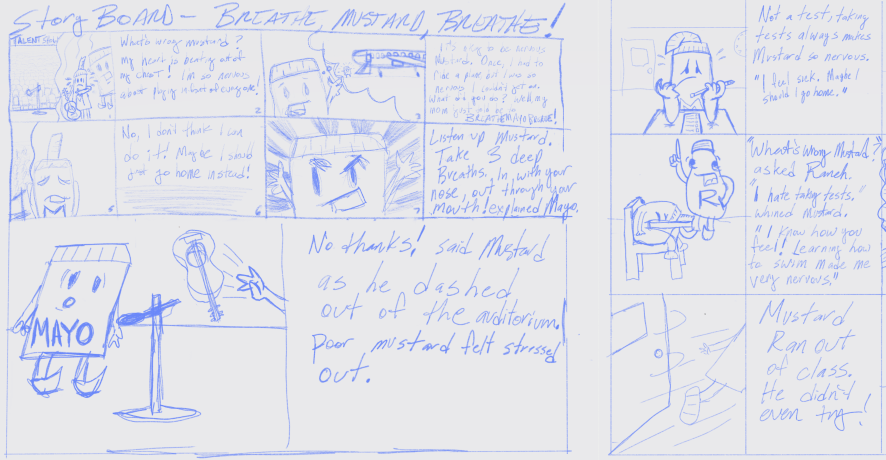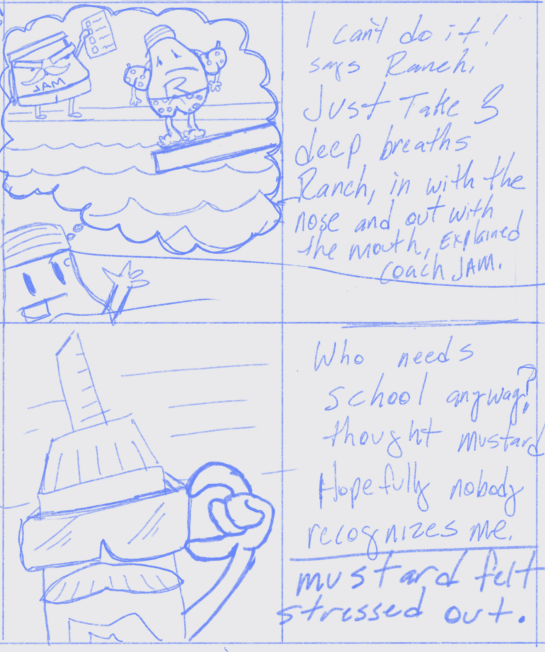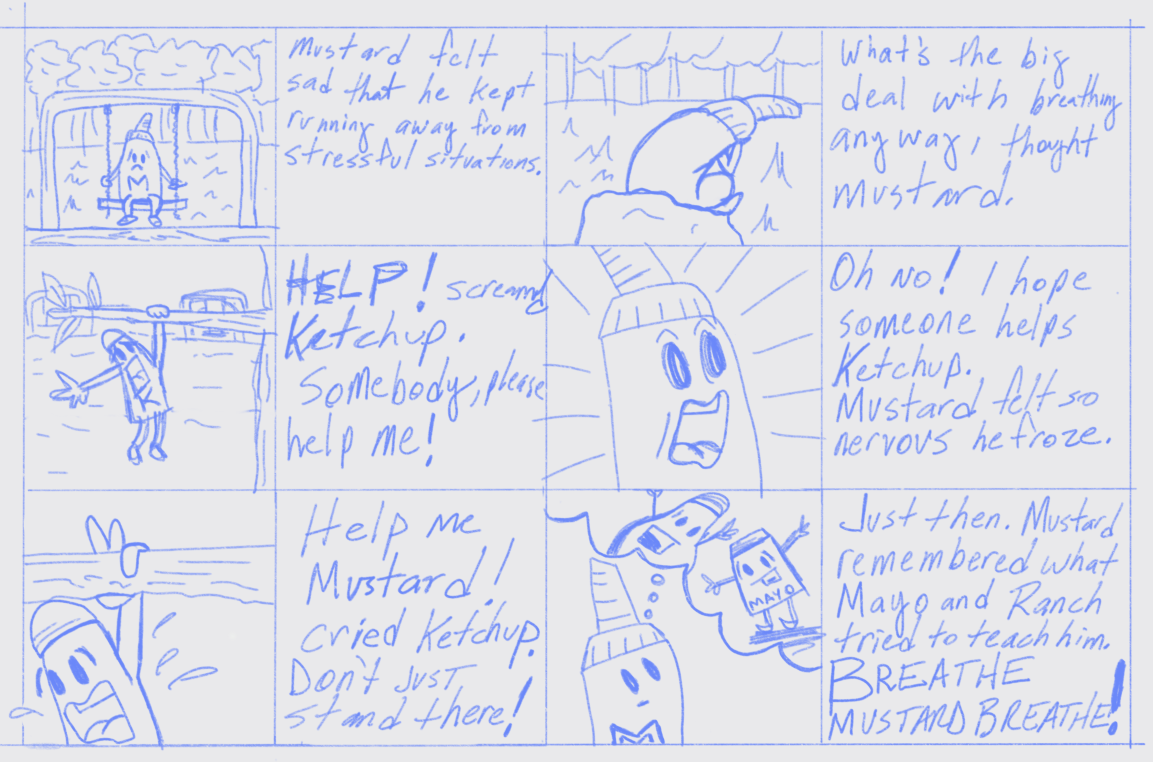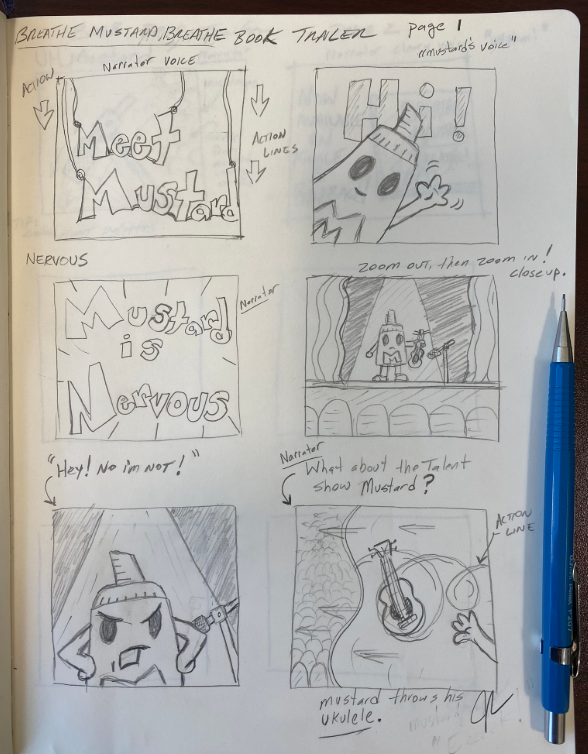Share your book dummy process?
-
I'm working on a dummy book too! They are a lot of work! lol. Here's how I'm doing it, (I don't think there is really a right or wrong way.)
- had a fully edited final draft ready before any drawing took place
- sketched character ideas
- Took the finished manuscript and started breaking it down into pages. (Much like Jake did on one of the SVS classes with little red riding hood)
- Did thumbnails of all the pages on paper
- Printed the text out for each page and drew the thumbnails larger and more refined on 8.5x11 paper and glued the text in the appropriate place
- scanned all of them into my computer and put them in a document together
- painted two finished spreads
Heres my thoughts on it...I don't know how I would have done this without a finished manuscript...I felt like figuring out the pace of the story was the hardest part and without a complete story I would be lost. Also, I ended up not liking the way I drew my characters so my final paintings are unusable as is most of my spreads because I'm drawing them different now. Problem is I've been working on this book for 8 years and I'm getting a little bored of it so who knows how long it will take me to finish!
Yours is looking great so far! I hope you do share more as you continue.
-
@xin-li Happy to share! I see that you are already setting your book up in this kind of storyboard format.
What I try to do these days is be very clear what the intention of each spread is. What is happening at this point in the story? And how do I want the viewer to feel as they make the page turn and experience the spread? I try to boil it down to one or two "keywords". These keywords go a long way toward suggesting composition, camera placement, character pose, value structure and color choices.
And I've found it's MUCH easier to dissect other illustrator's work first. Then apply that way of thinking to my own books.
I hope you give it a try with your favorite books. But don't overlook the value of doing this to books you hate. Especially if they are super popular. It may well give you an insight into why that "terrible" book is doing so well!
-
@davidhohn Thank you so much for this break down of the process. Really helps!
-
@theprairiefox thanks for the write-up and sharing your process.
Regarding to no.5
I found it very interesting that you review the text-only version with readers/editors. I am wondering if it matters with the type of stories? The story I am working on right now is very much depending on the illustrations to carry out the drama of the story. The size and placement of the characters and objects are essential for the story (it is hard to put these things in words, I think I have to thumbnail it out to make sense). I was thinking of waiting until I am in the rough sketch phase to have a reader/editor review.I always wondered the wordless picture book "Sidewalk flowers" illustrated by Sydney Smith, and written by JonArno Lawson, what was the manuscript looked like? and how much did the author and illustrator collaborated in the process?
Regarding to no.6
I love an add-on character, especially for younger children, they are wonderful to make book reading fun, slow-down.Regarding to no.8
Thanks for reminding me this. I also remember hearing Lee saying that at one of his lectures.Regarding to no.10
Do you have a critique group? I found it hard to get feedback from editors in the process. My office is in a creative collective, and I can ask co-workers from the collective to take a look of my dummy - some of them work with illustration, but the majority of people work in either game or advertising.
I subscribed Storyteller Academy this month to go through a book dummy course with Arree Chung
One thing that made a lot of sense to me is what he called "to have the end product in mind from the beginning". He encourages students to make the physical dummies the same size as the final book, to get the feel of the final product even in the early sketching stage. I will be doing this in my process. I thumbnail with pen and paper but do rough sketch digitally. So I will be printing out all rough sketches in real size, and glue them together to make my first real size dummy. -
@KaraDaniel Thank you for sharing your process.
I know that Will talked about their process always starts with a finished manuscript (in that SVS class with little red riding hood). But I find it counter-intuitive since illustration is telling half of the story, it is hard to leave it out in the beginning. I always have a hard time understanding how a picture book is done without author and illustrator working closely. I guess the only way for me to get it is to work on a picture book that is written by someone else. :-). -
@davidhohn thank you for the study tip :-). I need to visit the library to dig up a couple of terrible and popular books :smiling_face_with_open_mouth_closed_eyes:. I have never thought of study them in such a way.
I will always remember your lecture on emotional keywords. That was one of the best things I learned in 2019
-
@xin-li oh I definitely think a lot of writer/illustrators work on their manuscripts and illustration simultaneously and that works for a lot of people. I just like to have all my words first then use the pictures to enhance the story. (And I am in NO way a pro so I could be totally doing it wrong! Lol) Some books are only pictures, or just very few words. It depends on the book I guess. Seems like the way you are going about it so far is working out great.
-
Hi @xin-li, this is a great question. I'm also interesting in seeing other's work process.
Here's an example of my process, followed by printing and stapling 8.5x11 sheets together to simulate the physical book. These were very loose and fun sketches, but gave me the freedom to build up the tempo.
Oh yeah, before I forget - I also did the same thing with my book trailer (but in traditional pencil) - which I animated and created the music track. This is also shown below. I can send you a link to the trailer if you're interested in seeing how it came out.
Thanks!




-
Thanks @davidhohn! I love Beekle and pretty much all of Dan's work! So much so that I tried my hand at making the book cover of Dude in my copy covers for practice forum post.
Thanks for sharing the process, very helpful!
Jeremy
-
@davidhohn Very nice to see this example!!! Thanks for posting...I think the value study shapes are a great way to go...
-
@davidhohn and anyone else, I actually listened just yesterday to this podcast where Dan Santat discusses some of his characters including Beekle. In the beginning they play an audio clip of him winning the Caldecott for it. Which was fun. Here's the link for anyone interested https://www.breaker.audio/the-picturebooking-podcast-creating-publishing-and-marketing/e/5955851
-
@Jeremy-Ross I saw that post. Master copies like that are always useful!
-
@xin-li said in Share your book dummy process?:
have the end product in mind
I would agree with having the end product in mind from the beginning. I self-published a book by myself and the number of compromises and changes required because I didn't think about the end product was very high.
I am glad I had done the exercise of fully completing a book before really getting into illustration/writing full time. It really taught me about the things I didn't know and the lessons mean a lot more when you have practical knowledge of doing stuff the wrong way can get you into trouble.
On no. 5, my first editors (I use that term loosely) are a couple of people who can easily image into the images. I decided to do this as an extension of the process @Lee-White and @davidhohn gave us for illustrating. Take baby steps, provide options, choose the best one before moving to the next step. 50 Thumbnails -> 8 - Value Thumbnails -> 3 - Small Sketches -> 1 - Refined Sketch -> 1 - Final Picture. I would struggle to remove a character from my story if I had already done character design for them and got to know them. If they are just in the text I am a little less attached.
I did struggle a little bit with my more recent manuscript as there are pages in the dummy without any words (story through illustration). I solved that by creating simple text descriptions of the feelings and goals of the illustrations on those pages. This allowed the editor to follow along though I did learn during that process to be clearer in those descriptions.
On no. 10, I currently don't have a good critique group. I have a few editors/readers I will be using for this initially. Luckily, I have a family that is into literature and they have no qualms about giving me their opinion! I will use them for now, until I can establish a more formal group for this stage. One thing to note about feedback at this stage is the need for knowing the provider of the feedback and filtering the feedback through that lens.
-
@Jeremy-Ross looks really fun. Is the book you are working on a square book? I am curious if your thumbnails are idea sketches or the actual page spreads.
Yeah. Would love to see your book trailer

-
@Coley thanks for sharing the podcast. I love Dan Santat's work. And he is such a good speaker too.
-
@xin-li Do you mean a physical dummy you are sending to a publisher, or a physical storyboard?
-
@nadyart I refer "book dummy" as a physical dummy that represents a picturebook working in progress. I can upload some pictures when I am done with my first book dummy (probably sometime next week). What are the differences between dummy and storyboard in your definition?
Right now the sketch in my book dummy is no more detailed than thumbnails. I will take everything into a rough sketch phrase (add values, and making it more or less readable without much explanation notes), and probably make 2 -3 spreads into more detailed color sketches before sending my dummy to a publisher.
I will send the editor a digital version of the dummy (in PDF). The physical dummy is more for myself. I found it is easier to have the end product in mind if I make the dummy the same size as the final book. I also find it is easier to think about page turns when I have a physical dummy.
-
@xin-li I made a storyboard for my first picture book, with thumbnails and I also made more detailed sketches for all the spreads. But I did not create a physical booklet in the size of the book. That would have been very useful, but since I self published it, I did not send it to any publishers before hand. I was just wondering what to send to a publisher; the storyboard (in my case this was a page with all 12 thumbnail spreads), the larger more detailed sketches and/or these sketches printed out as a physical booklet (a dummy). Having read your explanation I think I will create a dummy as well

-
@nadyart From my research, a typical thing to send to an editor is a digital book dummy among other stuff they are asking for in their submission guideline. Many publishing houses have their own submission guideline, and art agencies also have their own. If you submit a picturebook manuscript to publishing houses and agencies, following their guideline is very important. It is kind of their first test to see if you are a good collaborator.
I think I will first send my book dummy to the editor who I worked with from the previous book. She has shown some interest to see my stories, so I just need to follow up on the thread by sending her my book dummy. The Norwegian publishing timeline is much shorter, I can get a book out in 6-9 months if the book is been bought. The communication loop is also much much shorter. What is it like in The Netherland?
I am very interested in working with chronicle books in the US. But I do not know how to go about it. I heard the waiting time after sending a manuscript is at least 6 months. I might just start by sending them postcards, and to see the possibility of doing illustrations for them first.
-
@xin-li said in Share your book dummy process?:
I am very interested in working with chronicle books in the US. But I do not know how to go about it. I heard the waiting time after sending a manuscript is at least 6 months
That's interesting - so you could end up sending a dummy book to chronicle but also some publishers in your own country and then by the time chronicle get back to you, you're already signed up and working on it with another publisher?